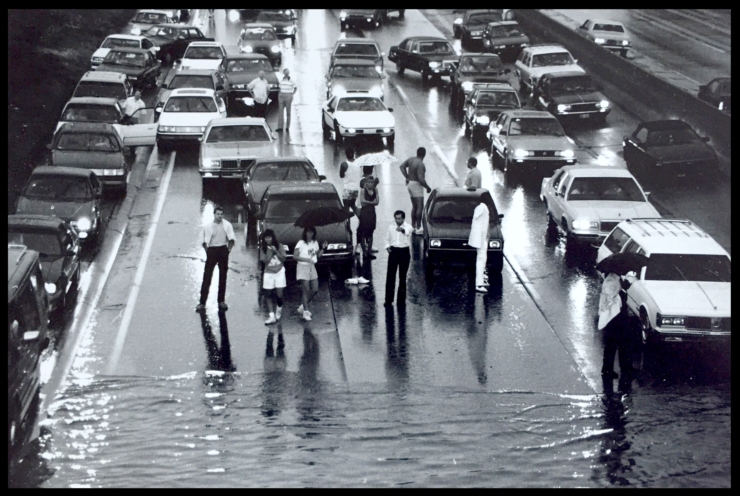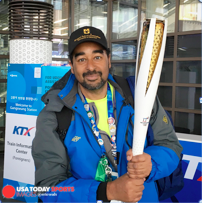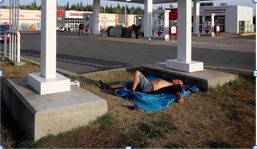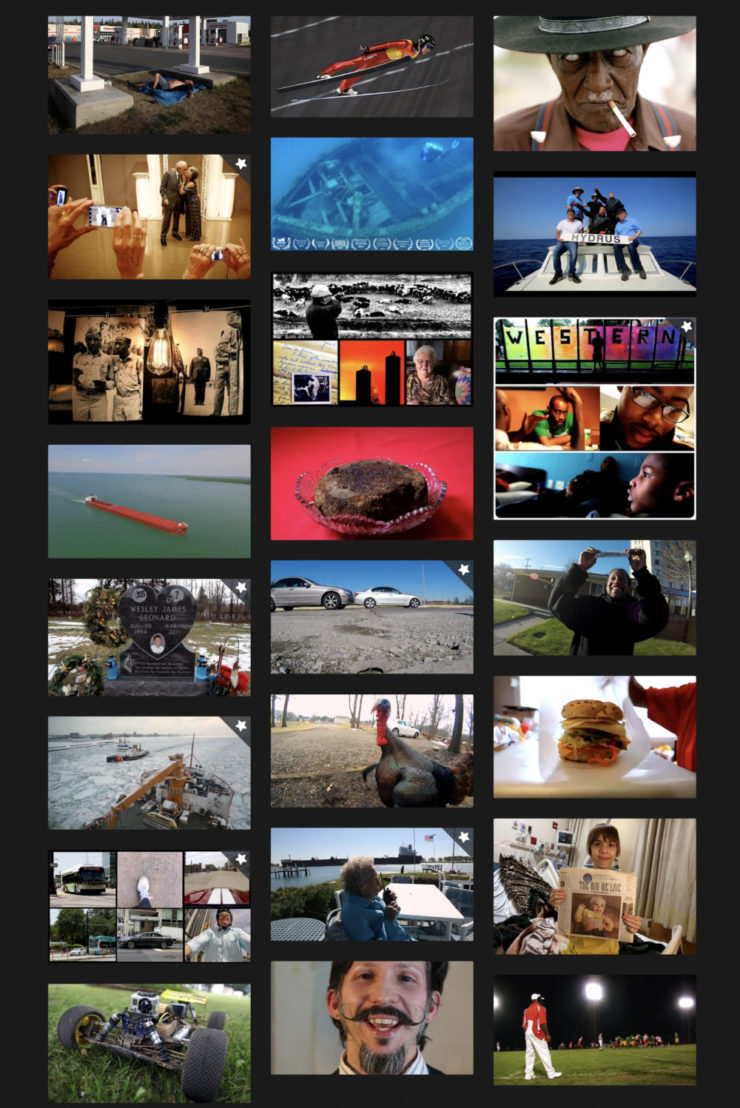Early in his career, Eric Seals adopted a straightforward mission statement from a former colleague: “If you learn to shoot with your heart you will move people’s souls.” That has guided him for 25 years as a photographer and video journalist for the Detroit Free Press, as has some wisdom borrowed from Hansel and Gretel: To make great video, you have to scatter good moments throughout, like breadcrumbs, to keep people engaged.
Seals has covered Infitadas in in the Middle East, the war in Iraq and sports events ranging from the Olympics to Super Bowls, World Series and NBA finals. But many of his most powerful stories come his hometown of Detroit.

Seals was still a teenager when he landed his first professional photo. It was July 30, 1988. He had just gotten out of a photography class at Oakland Community College and was driving to a party when traffic on the freeway came to a halt. Seals grabbed his camera and clambered up to an overpass to shoot the vast sea of cars and water spread out below him. Then he made one of those life-shaping decisions: He drove to the Detroit Free Press – an instinct he credits to his mother, who always emphasized the importance of taking risks so you never have to ask the “what if” questions later. Once in the newsroom, Seals politely told the photo editor that he had admired one of the paper’s recent projects. The editor looked at Seals’ film in the darkroom and offered to buy a few images. The next day, there they were, above the fold on Page 3A. By the time Seals got a check for $250 a few days later, he was hooked. He still gets emotional he thinks how life might be different if he had decided to go to the party that night.
Seals shared his story, and the stories behind some of his most memorable stories, earlier this month at the 28th annual conference of the Society of Environmental Journalists. While his tips focused on video stories, most of the lessons sit at the core of all good storytelling, and came with this encouragement for working in the digital age: "You are a triple threat if you can do photography and video." Sears says he was sent to the 2008 Olympics in Beijing because he had proven he could shoot sports, tell video stories and write a photo blog.
“Story trumps gear”

Photographers and video journalists are visual storytellers, Seals says. And like any good storyteller, you have to “grab people by the collar" and make them pay attention. The story you tell is more important than the gear you use to tell it. In pre-production, ask yourself: What is my story about? Write out that focus statement and keep it top of mind. Then create a detailed list of your needed shots and everything you know about them – not just on the surface but on a deeper level. Once you're on-site to shoot, keep an open mind for things that are unforeseen and out of your control. And always treat your photo subjects with respect; let them know what you’re doing, and why.
Find a great character
Choose characters who come alive with emotion and who viewers can relate to, like Ernie, the Sandwich Man. Character-driven stories make your audience laugh and cry.
Even so, characters are not always people. In this short video narrative about a fruitcake baked in 1878, the fruitcake itself became the main character. Seals said the story connected viewers to their own histories, but also was a sweet and humorous tribute to a sharp 92-year-old gentleman – a “loveable” narrator, according to Seals – whose vintage fruitcake made it all the way to The Tonight Show with Jay Leno.
One of his most memorable videos is the Michigan Emmy-winning Montford Marines – Trailblazers of History, in which he told the story of the black Marines who trained at Montford Point at Camp LeJeuene, then were deployed to the Pacific theater in WWII. Seals found the story when he was assigned to shoot portraits of four Marines in their late 80s and 90s. He had heard of the Buffalo Soldiers from the Civil War and of the Tuskegee Airmen, but had never heard of these Marines. He convinced his editor to let him shoot a documentary about the men, and things snowballed. Someone in Tennessee alerted him to photos of basic training of the black Marines at Camp LeJeuene. Seals bought a flatbed scanner and drove there to make copies. As it turned out, none of the Detroit Marines were in the photos, but they knew some of the officers from that time, including an infamous drill sergeant. The photos became a key prop in the video, giving the Marines a chance to reminisce about their experiences. They trained in segregated facilities, but spoke with pride about fighting as equals in the war. One told the story of coming back from war and, still in uniform, going to a café on Woodward Avenue in Detroit, only to be told that his color of money “don’t spend here.”
Seald says he had been unaware of that history until he made the documentary: “I get emotionally involved and attached and I wear my heart on my sleeve. I care so passionately about what I am photographing. ... it's great learning more about my culture, and it's even more special that others read that read the Free Press Story and watched my video learned something they not have known about each other." His video is now part of the continuous scroll in The National Museum of the Marine Corps in Virginia.
Make a video like you make a meal
Seals borrows from the Harris Watts analogy of cooking and filmmaking to describe his planning and production process. Without straining the metaphor here, this is his process:
- Create a Short Focus Statement
This is the point of your story in a sentence or two. Who is it about? Why did they do what they did? Why will your audience care? Write it down because it helps you focus!
For the Montford Marines, Seals' focus statement was “Men of history time forgot.” For Discovery of the Hydrus, a 52-minute award-winning documentary about a 1913 shipwreck of a freighter on Lake Huron: “The men of Michigan who risk their lives for history. We tell the tales of those under the sea who can no longer tell the tales themselves.”
This planning will help you remain calm in the chaos of making a video. Another way to think of it is like following a roadmap: Get your A-roll down first – the 20% made up of people talking directly in response to questions. Then gather B-roll – contextual shots of people, place and things. For each important scene, moment or image, take a wide shot, a closer shot and a close up. Shoot down and shoot up. Experiment.
- Determine the questions you need to ask
Ask for the why behind the what. Try not to ask a question twice. Use the B-roll to support your storytelling. Think in terms of sequences: Have material for your opening and closing. Imprint your questions in your head so that papers and other distractions won’t get between you and your character; you want to maintain good eye contact.
- Pre-interview
It’s important to know your characters and break down any barriers without the camera running. Help people understand why you are doing the story in the first place. That can often be done by phone, but Seals likes to hang out with people for a day to see what they do. This helps him ask the right questions when he records, and gather good B-roll.
- Arrange for time and get organized
Gather archival material or arrange for it to be available at your shoot so you don’t have to make a return trip. Check past stories and have a list of things you want to do after your main shoot.
- Build a thorough shot list
A shot list includes the people, places and things you need to shoot or record. This involves pre-imagining what you’ll need even before you pick up your gear. Write it down – but remain open to surprises. Plan for far more B-roll that you’ll likely need.
- Honor the audio
In video, you have to give the ears a break, Seals says. “You don’t want characters talking constantly and you need moments of natural sound. Your audio is the story. Our ears lead our eyes to the story being told. I do a radio edit where I just listen to the people talking. B-roll provides the rich sound for an audio bed that you run under your video like a wrapping on a sandwich. Start from the doorbell when you arrive for an interview. Collect audio even before you collect video."
- Open strong and keep the flow going
Just like a good lede paragraph in print, the first 15 seconds in video are crucial: “Make it catchy and colorful. Beautiful. Create a mood. You cannot take a break in video. You have to hold our interest through the entire piece. You want people to get lost in your video.”
He suggests shooting early or late in the day to avoid mid-day shoots in bright sun unless it is overcast. When editing, add some movement to your still photos to avoid a hard stop anywhere in your video. This is a basic edit function available in most editing programs. Test your work on colleagues, friends and family: “I have a lot to learn and am not afraid of asking producers to watch a five-minute piece and give me their opinion. I like to set the bar high and home in on people who are the best at what we do. I ask them what can be cut out to make it more precise? Where did you lose interest?”
- Never lose sight of your story focus
“Your job is to make something greater than the sum of its parts,” Seals says. “Figure out your rhythm and process for taking video and stick to it. Abandon the comfort zone because that is where the magic happens. It’s scary, fun and challenging work. Start with 90-second pieces and work up to more complex stories.”
The desire for video stories is growing in newsrooms, he says. At the Detroit Free Press, video is equally weighted on the page with the corresponding print story. Some news sites are more interested in quick bits of film – and that can work, too. “But you have to know what stories are worth taking the time," he says. "You don’t want to dumb things down for your audience. They will know the difference. A 60- to 90-second piece that is well done can give people something they can root for.”
And good video does take time. Pre-production is important. It takes time to create a piece and get the right mix. Editors need to understand that viewers will get more out of videos that are done right.

One of Seals' most recent pieces was The Battle Within, which involved a hunt to find Joe Murphy, a former Detroit Red Wings hockey star who was said to be struggling with mental health issues and living on the streets somewhere in Canada. Seals’ editor took a gamble and sent him to Kenora in Northern Ontario, to try and find him. “We found him under a gas station sign. I just walked up to him, made a quick introduction and told him we came all the way from Detroit to see him.”
The visual breadcrumbs in this story includes archival material from Murphy’s all-star hockey days. New footage, that reveals the tragedy of his current life, is shot from the heart.
Eric Seals: A primer on good gear
- He is a fan of the RØDE video mic that plugs into a GoPro or an iPhone.
- Filmic Pro audio app lets you monitor audio levels, which can be hard to do even with good camera gear.
- Bluetooth lavalier microphone by Sennheiser is a wireless, hands-free mic that provides good sound.
- Hindenburg audio software. It’s pricey – $300 for the computer version. But discounts are available for colleges and newsrooms and other multi-users. Check if you qualify.



